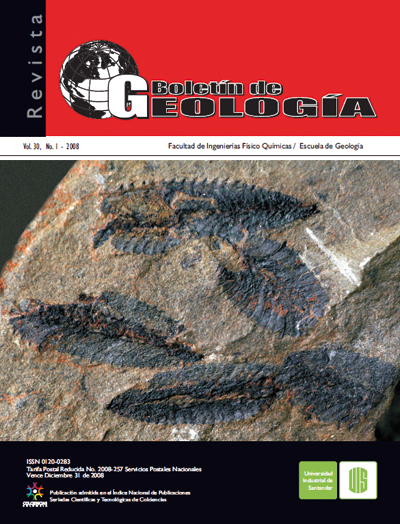ULTRABASIC-BASIC INTRUSIVE VIZCAINO LAYERED COMPLEX AND VIZCAINO OPHIOLITE (SOUTHERN BAJA CALIFORNIA, MEXICO)
Cómo citar
Resumen
Two ultrabasic-basic rocks-bearing units occur in the Vizcaino Peninsula of Southern Baja California (Mexico) : the Vizcaino Layered Complex (VLC) and the San Hipolito Zone (SHZ). The VLC consists of two sequences : the lower Puerto Nuevo Sequence (serpentinite breccia, harzburgite, dunite, cyclic units), and the upper La Pintada Sequence (cyclic units, gabbros, diorites). The SHZ consists of serpentinite, actinote schists. microgabbros, spilitic pillow lavas, ophicalcites, radiolarites, tuffs, greywackes, interbedded limestone and dolomite, siliceous sandstones, and volcanosedimentary strata). The VLC is an autochtonous complex generated by a magma underplating, which is intrusive into the San Pablo Metamorphic Complex (SPMC) (amphibole-biotite gneiss with lenses of granite, migmatitic amphibolitic gneiss, orthoamphibolites). Originally, together with its metamorphic roof, the SPMC, it constituted a continental magmatic arc .The SHZ, a former Late Triassic marginal sea, is an allochthonous Carnian (?)-Norian ophiolitic unit, emplaced as a nappe upon the VLC during the Liassic. During the Late Triassic (starting at ±220 Ma) this zone underwent a long lived extensional event, during which plagiogranite dykes and dolerite/albitite dykes were emplaced into it, whereas the San Hipolito Basin opened behind it. Then, different units of the VLC were exhumed and exposed by low angle normal listric faults. It seems that the upper part of the VLC, La Pintada Sequence and the SPMC were then displaced to their present position of San Pablo-La Pintada. During the Liassic compressional phase the plagiogranite dykes were boudinaged, and slices of the SHZ Nappe came to rest upon every one of the units of the Puerto Nuevo Sequence, including the serpentinite breccia (which gave way to the erroneous notion of the so-called Puerto Nuevo Mélange of previous literature).
Keywords: arc, marginal sea, magma underplating, ophiolite, Vizcaino, Baja California, tectonics
Descargas
Referencias
Castro-Leyva, T. 1992. Geoquímica de los Platinoides de las ofiolitas del Vizcaíno (Baja California Sur, México).Thesis, Universidad de Sonora, Hermosillo, Sonora, México
Davila, M.V. y Pessagno, A.E., 1986. Bioestratifrafía basada en radiolarios del Triásico en el noroeste de la Peninsula del Vizcaíno, Baja California Sur. UNAM, Inst. Geol. Revista,6: 136-144.
Desmons, J., Compagnoni, R. and Cortesogno, L., with the collaboration of Frey, M., Gaggero, L., Dallagiovanna, G., Seno, S. and Radelli, L., 1999, Alpine metamorphism of the Western Alps: II. High-P/T and related pre-greenschict metamorphism. Schweiz. Mineral.Petrogr. Mitt. 79: 111-134
Fyfe, W.S. 1992. Magma underplating of continental crust. In Cox, K.G and Baker, P.E., eds., Journal of Volcanology and Geothermal Research,19: 33-40
Ivrea-Verbano Zone Workshop, 1992. Abstracts, QUICK, J.E. and SINIGOI, S,, eds., U.S.Geol. Survey, Circular 1089, 30 p.
Kimbrough, D.L. 1985. Tectonostratigraphic Terranes of the Vizcaíno Penin-sula and Cedros and San Benito Islands, Baja California, México. Earth Sci.,: 285-297
Kimbrough, D.L., Moore, T.E. 2003. Ophiolite and volcanic arc assemblages on the Vizcaino Peninsula and Cedros Islandf, Baja California Sur, México: Mesozoic forearc lithosphere of the Cordilleran magmatic arc. Geological Society of America, Special Paper 374: 43 – 71.
Mina, V.F. 1956. Bosquejo geológico de la parte sur de la Peninsula de Baja California. 20th Intern. Geol. Congr., México, DF, Excursión A-7: 11-47
Moore, T.E. 1984a. Sedimentary facies and composition of Jurassic volcaniclastic turbidites at Cerro El Calvario. InFrizzel, V.A., ed., Geology of Baja California Peninsula, Society of Economic Paleontologists and Mineralogists, Pacific Section, 39: 131-147.
Moore, T.E. 1948b. Geodynamic significance of late Triassic and early Cretaceous volcanic sequences of Vizcaíno Peninsula and Cedros Island, Baja California, Mexico.Geology, 13: 31-35.
Moore, T.E. 1986. Petrology and tectonic implications of the blueschist-bearing Puerto Nuevo melange complex, Vizcaíno Peinsula, Baja California Sur, México, Geol. Soc. of Amer., Memoir 164: 43-58
Ortega-Gutierrez, F, Sedlock, S.L., and Speed, R.C. 1994. Phanerozoic tectonic evolution of México. In Speed, R.C., ed., Phanerozoic evolution of North American Continent-Ocean Transition. Boulder, Colorado, Geol. Soc. of Amer., DNG Continent-Ocean Transect olume,: 265-306
Perez Ramos, O. 2001. Bioestratigrafía del Pérmico en Sonora y consideraciones paleográficas.Tesis Doctoral, Posgrado Ciencias de la Tierra, UNAM, México D.F., 173 p.
Radelli, L. 1988a. La Nappe Olvidada et le sillon aptien-albien du Golfe de Californie. C.R. Acad, Sci. Paris, t. 306, Série II, p. 813-816
